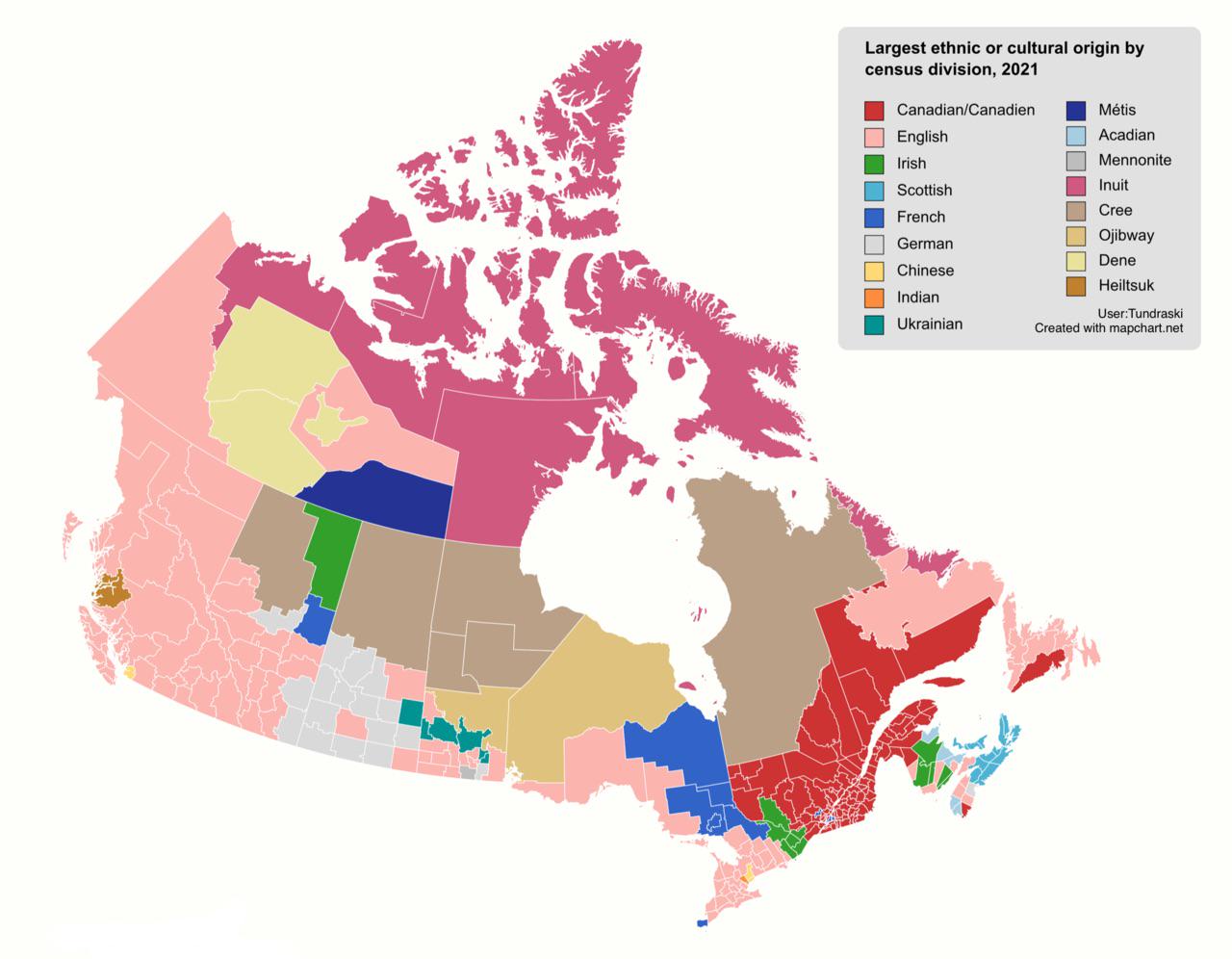Largest Ethnic Origins in Canada by Census Division Map


Alex Cartwright
Senior Cartographer & GIS Specialist
Alex Cartwright is a renowned cartographer and geographic information systems specialist with over 15 years of experience in spatial analysis and data...
Geographic Analysis
What This Map Shows
This map visualizes the largest ethnic or cultural origins across Canada based on the 2021 census data. By breaking down the information into census divisions, it provides a detailed look at the diverse tapestry of Canada’s population. From the bustling urban centers to the quieter rural areas, the ethnic origins depicted tell a story of migration, settlement, and cultural evolution that shapes the Canadian identity.
Deep Dive into Ethnic Origins in Canada
Canada is renowned for its multiculturalism, a characteristic that stems from centuries of immigration and Indigenous history. According to the 2021 census, the largest ethnic or cultural origins in Canada include English, French, Scottish, Irish, German, Italian, Chinese, and Indigenous peoples, among others. Each of these groups has contributed to the broad spectrum of Canadian society.
Interestingly, the concept of ethnic origin is not just about ancestry but also reflects cultural practices, languages, and community ties. For instance, the presence of a significant Chinese community in cities like Vancouver and Toronto highlights the historical migration patterns that date back to the 19th century. The establishment of Chinatowns in these urban areas has not only preserved cultural heritage but also enriched the local economy and influenced cuisine, festivals, and community events.
Have you noticed that some regions have a predominant ethnic origin? For example, Quebec stands out with its strong French heritage, which is a result of early French colonization. French Canadians represent a significant portion of the population and continue to maintain their language and culture, influencing everything from education to politics in the province.
The map also shows how Indigenous communities, which include First Nations, Métis, and Inuit, are distributed across different provinces. These groups possess unique cultural identities, languages, and traditions that contribute to the overall cultural landscape of the country. For instance, the presence of Indigenous peoples is particularly prominent in the northern territories and parts of British Columbia and Manitoba. Their history is interwoven with the land, and understanding their origins sheds light on Canada’s past and present.
Moreover, demographic trends indicate that Canada is becoming increasingly diverse. The 2021 census highlighted a rise in populations identifying with multiple ethnic origins. This trend reflects the growing acceptance of multiculturalism and the blending of cultural practices, which is essential for fostering social cohesion in an increasingly interconnected world.
Regional Analysis
When examining the map, regional differences become apparent. In the Atlantic provinces, for example, English, Irish, and Scottish origins dominate, reflecting centuries of settlement patterns. Nova Scotia, with its rich Scottish heritage, celebrates events like the Highland Games, which showcase traditional music, dance, and athletic competitions.
In contrast, the Prairie provinces present a different picture. Alberta and Saskatchewan are home to significant populations of German and Ukrainian descent, a legacy of the mass immigration during the late 19th and early 20th centuries. The cultural festivals in these provinces, such as the Edmonton Heritage Festival, celebrate this rich diversity and foster a sense of community.
On the other hand, urban areas such as Toronto and Vancouver exhibit a mosaic of ethnic origins. Toronto is one of the most multicultural cities globally, with over 50% of its population identifying as a member of a visible minority. This diversity is evident in the city’s neighborhoods, cuisine, and cultural events, making it a microcosm of global cultures.
Significance and Impact
Understanding the ethnic origins of Canada’s population is crucial for various reasons. It helps inform public policy, social services, and education systems that cater to a diverse population. Furthermore, recognizing the contributions of different ethnic groups fosters inclusivity and unity, essential for a harmonious society.
Current trends indicate that Canada will continue to evolve demographically. With increasing immigration and the growing recognition of Indigenous rights and histories, the ethnic landscape will likely become even more complex. This evolution poses both challenges and opportunities for Canada as it navigates its identity on the global stage.
In conclusion, the map of the largest ethnic or cultural origins in Canada by census division is more than just a visualization; it’s a reflection of the nation’s story. Each ethnic group adds a unique thread to the Canadian fabric, illustrating how diversity can be a source of strength and resilience in an ever-changing world.
Visualization Details
- Published
- September 19, 2025
- Views
- 76
Comments
Loading comments...